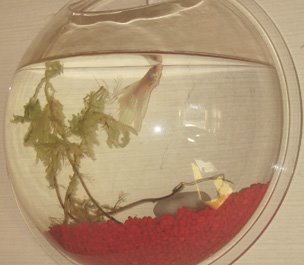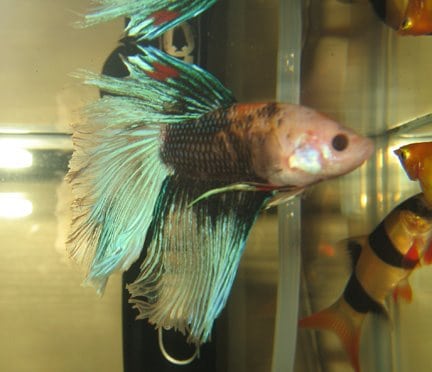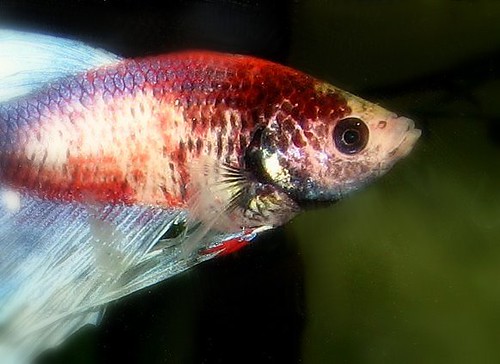In our last article we spoke about bettas that naturally change color over time. A Nippyfish reader wrote in concerned about some pretty serous color changes. Well, she sent in some photos of her betta fish and it became immediately obvious that she has a Marble Betta. “Marble” is used to describe a type of betta fish by its physical blotchy appearance but more importantly by the special genes they have called, jumping genes or Transposons as they are now called.
These Transposons are what make marble bettas notorious color changers. Genes are responsible for a variety of things. With bettas, we study genes to understand and modify (through breeding) particular traits like color, pattern and fin style. A royal blue betta is blue because it has the blue gene. Transposons have the ability to do two important things that affect a betta’s color:
1. Insert itself into another gene and change its function. For example, it can insert itself into that same royal blue gene effectively saying “you no longer produce color” therefore changing its function. The gene no longer acts to produce the royal blue and the betta becomes colorless in part. Some jumping genes can also change the color which means some bettas can go from one color to a completely different color over time.
2. The second important function of a jumping gene is its ability to… well… jump of course. Through the chromosomes these genes can move reinserting itself into other genes. This is what allows a marble betta to change continuously over the course of its life. Let’s go back to the example of the royal blue betta. The blue gene was overridden by the Transposons creating a loss of pigment. When the jumping gene moves on, the blue gene returns to its normal function and the blue pigment returns. When the jumping gene moves to another location, it may then override the function of the new gene.
It is my understanding that the Transposons is a genetic trait specific to marbled bettas, which makes them more likely to illustrate a greater variance of color change throughout their lives. For hobbyists, keeping marbled betta fish is fun and exciting. For betta breeders, these can create unique challenges as it is difficult to predict what they will get. Over time, some marbled bettas may turn completely solid or loose color entirely.
 Our Reader’s marbled betta fish 6 Months ago
Our Reader’s marbled betta fish 6 Months ago
 The same betta 3 months ago
The same betta 3 months ago
 The vary same betta today
The vary same betta today

Wow, that’s the most change in a betta I’ve ever seen. Incredible.
I have a marble betta, it seems too. When I bought it, it was all white. Now it’s got blue and red in it’s fins, but the body is mostly still white.
when i got my betta he was all pink now he is a little pink but mostly blue and black, so cool!
They are pretty cool looking bettas aren’t they? I don’t really see them at the big pet stores these days. I guess they are still more popular to buy from breeders.
I’d have to say we got very lucky, then, as we bought this little guy at our local Petsmart or one of those huge comglomerates. We thought the white was very cool and he was the only one there, stuck way in the back. I’m glad we found him, his displays are fantastic and he’s obviously much happier! We’re definetly hooked on Bettafishy’s now. Thanks so much for all your help! <3
my betta fish changes from stripes to solid color in hours. do you know why?
if they are vertical stripes they could mean your betta is stressed…if your betta is a female horizontal stripes indicate she is ready to breed, but vertical ones mean stress
I believe you have that reversed Anon. Vertical stripes (up and down) are a signal to the male that she is ready to breed while horizontal (left to right) are what what call “fear stripes”.
my betta is royal blue, but it can turn from blue and green to blue and red whenever it wants to.
I have a crowntail that did the exact same change, except he went from the bottom picture to the top picture. He started out with a black body/face, and now he’s flesh colored. His fins went from black and red and white to white with small amounts of red. And yes, he’s still eating well and doesn’t seem sick or stressed… so I don’t know what’s going on!
Oh my gosh, so glad you posted this! I bought a pink King Betta Fish at Petco a few months ago. We named him pink because he is entirely pink. Today I noticed that he was turning greyish black. I panicked. Thank goodness for google and your pictures of the above fish. He looked just like this fish did and the black color is the same now too. Wow! I think I have a fish that is changing color and NOT because something is wrong. Whew. Thanks! I’ve got pictures if anyone wants to see the before and after.
Glad we could help Sheri.
I have seen this same color change in my betta “Grumpy”. I was wondering if changing surroundings can affect or trigger the change? We moved grumpy from a two and a half gallon bowl, to a ten gallon tank for himself. Now he is in a 29 gallon with 4 other fish. In a matter of weeks he went from predominantly white to blue. I noticed in the picture it appears as though the betta is now in a tank with other fish as well.
I have three betta’s in a 2-1/2 gal divided tank. They ignore each other most of the time but are all changing color. Arthur the red fish is now changing to purple my purple betta is now deep blue and burple and my pink is now also turning purple. They seem to be copying each other is this possible.
susan
My betta was a beautiful purple and royal blue but now i have recently noticed his purple isnt as dark as it was and the royal blue has turned bright white.Is this normal or is something wrong.
Im so glad I finally found the answer to why my bettas were changing colors. I have two half moon, both in their own five gallon tanks. I got them from petsmart when they were both flesh colored with clear tails and I freaked out when they started changing colors, especially considering that their tank levels were just about perfect and they appeared to be completely happy. Now one is slowly turning black and the other one has taken on a pale purple color.
Woo~ Atleast now I know not to be concerned. Im happy that they arent sick or anything, just unique ^^
It looks like this beta is just gaining it’s color. Real Marble Betas change color from say blue, black, and orange to maybe green, yellow, and red and change like that. I don’t think that’s a Marble Beta
I bought a white one and called him Angel. Now 6 months later he is completely black. So I guess I have to change his name.
I have a marble CT who is turning color after having him for a few months
My betta fish changed his color from all black to Black, Red-ish and light blue. i was shocked. until now, i have never known that there is a Marble Betta Fish…
lawl….
I got a betta about 2 weeks ago and he continues to change colors when I got him he was a beautiful silver color now he gets black and red blue and red and silver sometimes almost tank in silver he eats well and is very healthy after reading these articles I feel much better about him and his color changes
I have a Betta who I named ghost because he was all white with a little bit of black marbling on his body. His fins were transparent and had a little lavender irredescent in certain light. Seemingly overnight his body turned a deep navy blue.
My pale beta with light blue highlights is turning black. I was worried that it was some kind of fungus or disease, but maybe it’s just a normal color change? I hope so.
I’m so glad this is normal (the color changing.) my little guy named joji is pink, and has always had a bit of black at the tip of his tail. today, he seemed to be changing to blue. I was worried he was sick, but it turns out he’s not and is just a marble betta so yay!
I have a blue crown tail betta with turquoise stripes .after about 6 months , hes changing to light blues spots with white , red , light blue fins. do the crowntail s be marbled too?